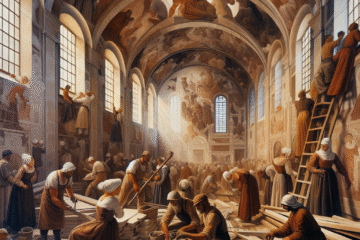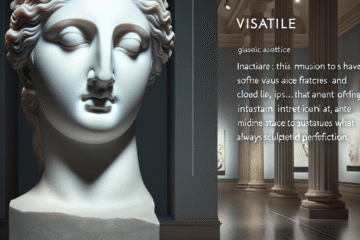I. Introduction
Abstract Expressionism is a movement in modern art that emerged in New York City after World War II. It is characterized by the use of large canvases, spontaneous and gestural brushstrokes, and a focus on the process of creation rather than the final product. This art form is often associated with a rejection of traditional representation and a deep exploration of the subconscious. In this article, we will explore the definition, history, and importance of Abstract Expressionism.
A. Definition of Abstract Expressionism
Abstract Expressionism is a form of abstract art that emerged in the United States after World War II. It is characterized by its large canvases, spontaneous and gestural brushstrokes, and focus on the process of creation rather than the final product. This art form is often associated with a rejection of traditional representation and a deep exploration of the subconscious. Abstract Expressionism is sometimes referred to as the first truly American school of art.
B. Brief history of Abstract Expressionism
Abstract Expressionism first emerged in New York City in the 1940s. This movement was the first to gain international recognition for American art and was largely driven by a group of artists who had immigrated to the United States from Europe. These artists, including Jackson Pollock, Willem de Kooning, Mark Rothko, and Franz Kline, were influenced by the Surrealist and Expressionist movements, as well as the ideas of philosopher Friedrich Nietzsche.
Abstract Expressionism gained popularity in the 1940s and 1950s, and its influence can be seen in the work of many artists who followed. This movement was particularly influential in the United States, but its impact was felt around the world. Abstract Expressionism played a major role in the development of subsequent art movements, including Pop Art and Minimalism.
C. Importance of exploring the aesthetics of Abstract Expressionism
Abstract Expressionism is an important movement in modern art and continues to be relevant today. Its emphasis on the process of creation and exploration of the subconscious has had a profound impact on the art world and popular culture. By studying the aesthetics of Abstract Expressionism, we can gain a deeper understanding of the role of the artist and the exploration of the human condition.
Additionally, the gestural brushstrokes and dripped paint used in Abstract Expressionism have inspired many contemporary artists, and its influence can be seen in the work of artists working in a variety of mediums today. Understanding the aesthetics of Abstract Expressionism is therefore essential for anyone interested in the history of modern art and its impact on contemporary culture.
In conclusion, exploring the aesthetics of Abstract Expressionism is an important step in understanding the history and evolution of modern art. Its emphasis on the process of creation and exploration of the subconscious continues to be relevant and inspiring to artists and art lovers alike.
II. Characteristics of Abstract Expressionism
Abstract Expressionism is a movement in modern art characterized by its large canvases, spontaneous and gestural brushstrokes, and a focus on the process of creation rather than the final product. In this section, we will explore the key characteristics of Abstract Expressionism and what makes it unique among other art movements.
A. Use of gestural brushstrokes and dripped paint
One of the defining characteristics of Abstract Expressionism is the use of gestural brushstrokes and dripped paint. This technique involves applying paint to the canvas in a spontaneous and intuitive manner, often using a dripping or splattering technique. The goal of this technique is to capture the energy and emotion of the artist’s process and to allow the work to evolve organically.
B. Emphasis on the process of creation
Abstract Expressionism places a strong emphasis on the process of creation, rather than the final product. Artists working in this style sought to capture the energy and emotion of the creative process, rather than simply creating a finished work of art. This focus on the process was seen as a rejection of traditional representation, as well as a celebration of the artist’s own individuality and personal expression.
C. Rejection of traditional representation
Abstract Expressionism is often associated with a rejection of traditional representation, such as realistic depictions of the world or the human form. Instead, Abstract Expressionists sought to create abstract, non-representational works that explored the subconscious and the inner world of the artist. This rejection of traditional representation was seen as a way of freeing the artist from the constraints of representation and allowing them to fully express themselves in a new and innovative way.
D. Exploration of the subconscious
Abstract Expressionism is often associated with an exploration of the subconscious, as artists sought to capture the inner world of their minds and emotions. This exploration was seen as a way of tapping into the unconscious and revealing the innermost thoughts and feelings of the artist. The use of gestural brushstrokes and dripped paint was seen as a way of expressing this inner world and giving form to the intangible aspects of the artist’s subconscious.
In conclusion, the characteristics of Abstract Expressionism, including the use of gestural brushstrokes and dripped paint, the emphasis on the process of creation, the rejection of traditional representation, and the exploration of the subconscious, make this movement a unique and innovative contribution to modern art. These characteristics continue to inspire artists and art lovers alike, and the impact of Abstract Expressionism can be seen in the work of many contemporary artists working in a variety of mediums.
III. Key Artists of Abstract Expressionism
Abstract Expressionism was a movement that emerged in New York in the 1940s and 1950s, and was characterized by large, spontaneous and gestural brushstrokes and a focus on the process of creation. This section will examine some of the key artists of Abstract Expressionism and their contributions to this movement.
A. Jackson Pollock
Jackson Pollock is widely considered to be one of the most important artists of Abstract Expressionism. He is best known for his “drip paintings,” large canvases covered in layers of dripped and splattered paint. Pollock’s innovative use of paint and his focus on the process of creation, rather than the final product, earned him a reputation as one of the most influential artists of the 20th century.
B. Willem de Kooning
Willem de Kooning was a Dutch-American artist who was a key figure in Abstract Expressionism. He is best known for his series of abstract portraits, in which he used gestural brushstrokes to explore the female form. De Kooning’s works are notable for their sense of movement and energy, and for their rejection of traditional representation in favor of abstract, non-representational forms.
C. Mark Rothko
Mark Rothko was an American artist who is considered one of the leading figures of Abstract Expressionism. He is best known for his large, colorful abstract canvases, which are characterized by blocks of color and a focus on the emotional impact of color and form. Rothko’s work has been described as contemplative and introspective, and he is considered to be one of the pioneers of Color Field painting.
D. Franz Kline
Franz Kline was an American artist who was a key figure in Abstract Expressionism. He is best known for his large, black-and-white canvases, in which he used gestural brushstrokes to create abstract, non-representational forms. Kline’s work is notable for its focus on the energy and movement of the brushstrokes, and for its rejection of traditional representation in favor of abstract forms.
In conclusion, these key artists of Abstract Expressionism, including Jackson Pollock, Willem de Kooning, Mark Rothko, and Franz Kline, made important contributions to the movement and continue to inspire artists and art lovers alike. Their innovative use of paint, focus on the process of creation, and rejection of traditional representation continue to define Abstract Expressionism as one of the most important and influential art movements of the 20th century.
IV. Themes and Motifs in Abstract Expressionism
Abstract Expressionism was a movement that was characterized by large, gestural brushstrokes, a focus on the process of creation, and a rejection of traditional representation. Despite its non-representational form, Abstract Expressionism is rich in themes and motifs that explore the human condition, the role of the artist, the search for identity, and the exploration of space and color.
A. The human condition
Many Abstract Expressionist artists sought to explore the human condition through their art. They believed that the act of painting was a way to access and express the subconscious, and to reveal the underlying emotions and anxieties of the human experience. Through their use of gestural brushstrokes and dripped paint, Abstract Expressionist artists sought to capture the energy and unpredictability of the human psyche.
B. The role of the artist
Abstract Expressionism was also characterized by a focus on the role of the artist as a creator. The emphasis on the process of creation, rather than the final product, was seen as a way to reject traditional expectations of the artist and to assert the importance of the artist’s vision and creativity. By exploring the act of painting as a means of self-expression, Abstract Expressionist artists sought to assert their individuality and to challenge traditional ideas about the role of the artist in society.
C. The search for identity
Another theme that emerges in Abstract Expressionism is the search for identity. Many artists used their paintings to explore their own personal experiences, emotions, and anxieties. Through their use of gestural brushstrokes and abstract forms, they sought to uncover the underlying emotions and struggles that defined their own experiences. By exploring these personal themes, Abstract Expressionist artists were able to assert their own identities and to challenge traditional notions of self and individuality.
D. The exploration of space and color
Abstract Expressionist artists also explored the use of space and color in their paintings. By using large canvases and blocks of color, they sought to create a sense of depth and spatial relationships that went beyond traditional representation. The use of color was also seen as an important aspect of the emotional impact of the painting, with artists exploring the effects of different hues and combinations on the viewer’s emotions.
In conclusion, despite its non-representational form, Abstract Expressionism is rich in themes and motifs that explore the human condition, the role of the artist, the search for identity, and the exploration of space and color. Through their use of gestural brushstrokes and abstract forms, Abstract Expressionist artists sought to capture the underlying emotions and struggles of the human experience and to assert their individuality and creativity.
V. Influence of Abstract Expressionism
Abstract Expressionism was one of the most influential art movements of the 20th century. Its impact on the art world, popular culture, and later art movements cannot be overstated. In this section, we will explore the ways in which Abstract Expressionism has influenced these various spheres.
A. On the art world
Abstract Expressionism had a profound impact on the art world of the mid-20th century. Its focus on the process of creation and the rejection of traditional representation challenged traditional ideas about what art could be. This shift in thinking helped to lay the groundwork for the development of later art movements, such as Pop Art and Minimalism. The emphasis on the role of the artist as a creator also influenced later artists, who sought to assert their own individuality and to challenge traditional expectations of the artist.
B. On popular culture
Abstract Expressionism also had a significant impact on popular culture. Its use of bold colors and gestural brushstrokes was seen as a form of rebellion against traditional art forms, and its influence can be seen in a variety of popular culture references, from film and television to fashion and design. The work of Abstract Expressionist artists continues to inspire contemporary artists and designers, who use their innovative techniques and bold styles to create their own unique visions.
C. On later art movements
Abstract Expressionism also had a profound influence on later art movements. Its focus on the process of creation and the use of abstract forms and colors helped to lay the groundwork for the development of later art movements, such as Minimalism, Pop Art, and Conceptual Art. The work of Abstract Expressionist artists continues to inspire contemporary artists, who use their innovative techniques and bold styles to create their own unique visions.
In conclusion, the influence of Abstract Expressionism cannot be overstated. Its impact on the art world, popular culture, and later art movements continues to shape the way that we think about and create art. Its bold use of gestural brushstrokes, bold colors, and emphasis on the process of creation challenged traditional ideas about what art could be, and continues to inspire artists and designers to this day.
VI. Conclusion
Abstract Expressionism was a major art movement of the mid-20th century, characterized by its use of gestural brushstrokes, dripped paint, and emphasis on the process of creation. Key artists of the movement included Jackson Pollock, Willem de Kooning, Mark Rothko, and Franz Kline. The movement was also marked by a focus on themes such as the human condition, the role of the artist, and the exploration of space and color.
A. Summary of the main points
In this article, we have explored the various aspects of Abstract Expressionism, including its definition, history, and key artists. We have also looked at the characteristics of the movement, including its use of gestural brushstrokes and dripped paint, its emphasis on the process of creation, and its rejection of traditional representation. We have also explored the themes and motifs of the movement, including its focus on the human condition, the role of the artist, and the exploration of space and color.
B. Reflection on the continued relevance of Abstract Expressionism
Despite being a movement that emerged over 60 years ago, the relevance of Abstract Expressionism continues to this day. Its bold use of gestural brushstrokes, bold colors, and emphasis on the process of creation challenged traditional ideas about what art could be, and continues to inspire contemporary artists. The work of Abstract Expressionist artists remains an important touchstone for artists who seek to push the boundaries of what is possible in art.
C. Final thoughts on the importance of exploring the aesthetics of Abstract Expressionism
Exploring the aesthetics of Abstract Expressionism is important for several reasons. First, it provides insight into the cultural and artistic trends of the mid-20th century. Second, it helps us to understand the ways in which art can be used to challenge traditional ideas and to push the boundaries of what is possible. Finally, exploring the aesthetics of Abstract Expressionism provides a window into the creative process of the artists of this movement, and helps us to better understand their unique vision and approach to art.
In conclusion, Abstract Expressionism was a major art movement that continues to influence the art world, popular culture, and later art movements to this day. Its bold use of gestural brushstrokes, bold colors, and emphasis on the process of creation challenged traditional ideas about what art could be, and its impact continues to be felt in the work of contemporary artists. The importance of exploring the aesthetics of Abstract Expressionism lies in its ability to provide insight into the cultural and artistic trends of the mid-20th century, to challenge traditional ideas, and to better understand the creative process of the artists of this movement.


